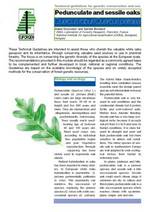Quercus robur and Quercus petraea - Technical guidelines for genetic conservation and use for pedunculate and sessile oaks
This publication has been translated into the following languages:
The forest reproductive material transfer in international trade must be in agreement with EU Directives and the OECD scheme. All scientific studies are congruent for the promotion of local material. Forest managers are urged to follow these guidelines:
1) Natural regeneration must be a priority.
2) Reproductive material must be transferred only at a local scale; transfers among provenance regions must be strictly limited. Foresters must use genetic resources for artificial regeneration from local seed stands, that have been selected for their phenotypic values and silvicultural histories.
3) Development of seedlingraising agreements between nurseries and forest managers is needed.
At present in Europe, these genetic resources are not really endangered except in some situations (marginal populations in coastal sand dunes or peatbogs; altitudes >1400 m) and at the limits of the natural range. These genetic resources are potentially threatened by introduction of exotic genotypes, species purification, neglected practices and conversion to high forest. For these reasons, we recommend development of programmes of gene conservation with the following objectives:
1) Sampling of genetic diversity: sampling strategies defined empirically or according to results obtained with molecular and quantitative markers.
2) Conservation of evolutionary mechanisms: the high genetic diversity of white oaks is the result of evolutionary mechanisms such as interspecific hybridization.
3) Conservation of oak ecosystems: humans have created ecotypes adapted to different management for wood production and acorn crops. Most of these management systems are neglected because foresters have undertaken conversion to high forest.
4) Conservation of endangered populations and minor species: marginal or endangered populations in Europe need conservation measures. The first step is to take a census, then define a policy for each situation.
In situ conservation methods should be generally preferred. If natural regeneration methods are not sufficient, an adapted and specified ex situ conservation programme including a controlled autochthonous reproductive material system (e.g. clonal seed orchards) should be used as well to preserve the endangered genepool.
Authors: Alexis Ducousso; Sándor Bordács
Journal/Series: EUFORGEN Technical Guidelines for Genetic Conservation and Use
Publication Year: 2003
Publication Format: Folder; PDF
ISBN: 92-9043-660-3
ISBN 13: 978-92-9043-660-7
Language: EN
Pages: 6 p.

